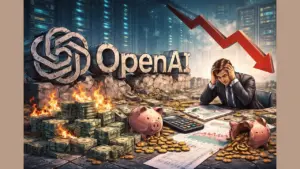Introduction
Artificial Intelligence (AI) is everywhere. Executives promise it will change software development forever. Investors pour millions into AI-powered coding tools. Startups pitch that one developer with ChatGPT can do the work of ten engineers. The dream sounds irresistible. But the reality is messy.
I see it first-hand. Companies call me when their AI-generated code collapses under real-world pressure. They expected to ship software fast. Instead, they ship bugs, delays, and chaos. In this article, we explore why AI-generated code often fails, the difference between writing code and building software, and how leaders can avoid becoming victims of the hype.
The Hype Cycle of AI-Generated Code
The hype around AI coding tools is intense. Boards hear promises of instant productivity. Leaders imagine huge cost savings. Pitch decks with “AI” in bold letters attract investors. Some even believe they no longer need full teams of engineers.
But hype rarely matches delivery. Tools like ChatGPT, Copilot, and similar models can generate code snippets. Yet they lack context, architecture, and business understanding. Without strong engineering discipline, generated code becomes a liability. Multi-million-dollar initiatives collapse faster than a house of cards. The hidden cost shows up in maintenance, debugging, and security flaws.
Leaders must understand that AI is a tool, not a magic wand. Without planning, oversight, and expertise, AI-generated code turns from a promise into a problem.
Code vs. Software: The Crucial Difference
Writing code and building software are not the same. Code is just text. Software is a system. It includes design, architecture, scalability, testing, security, and maintenance.
AI can generate code, but it cannot design a scalable system or handle complex edge cases on its own. This is where many executives get it wrong. They assume that producing code equals producing software. In reality, software engineering is an end-to-end process. It involves discovery, planning, architecture, integration, and long-term support.
A single developer with AI tools may generate thousands of lines of code. But if nobody understands that code, it’s like building a skyscraper without blueprints. The result looks impressive until it collapses.
This is where experienced professionals—including a fractional CTO—become essential. A fractional CTO provides senior-level technical leadership without the cost of a full-time executive. They ensure that AI-generated code fits into a secure, scalable, and maintainable architecture.
“Vibe Coding” and Its Consequences
Many AI-driven projects fall into what I call “vibe coding.” Teams copy and paste AI-generated code without understanding it. They build features on top of features without a clear architecture. Everyone assumes someone else knows how it works. In reality, no one does.
This approach leads to fragile products. When something breaks, debugging becomes a nightmare. Security vulnerabilities slip through. Performance issues escalate. Compliance problems appear at the worst possible moment.
Vibe coding creates technical debt at record speed. Startups that embrace it may launch quickly, but they crash even faster. Without a strong engineering backbone, AI-generated code becomes a ticking time bomb.
The Real Cost of AI Code Disasters
Emergency calls from companies drowning in AI-generated code are becoming common. They expected efficiency but got chaos. Cleaning up these messes costs far more than building software properly from the start.
Budget overruns are the first sign. Deadlines slip. Investor confidence erodes. Teams burn out trying to patch unstable codebases. Customers lose trust when products fail or expose sensitive data.
The cost is not just financial. It’s reputational. Startups that launch buggy products lose credibility. Enterprises that ship broken software risk legal exposure. Regulatory compliance becomes harder when code is opaque and untested.
Hiring a fractional CTO early can prevent these disasters. They set standards, choose appropriate AI tools, and implement review processes. This hybrid approach—AI plus human expertise—protects the company’s long-term value.
How to Avoid Becoming a Victim of the Hype
1. Understand AI’s Limitations
AI coding tools are assistants, not replacements. They speed up repetitive tasks but cannot replace human judgment. Treat AI-generated code as a draft, not production-ready software.
2. Invest in Experienced Leadership
Bring in senior engineers or a fractional CTO to guide AI adoption. They can evaluate tools, oversee code quality, and align development with business goals. This reduces risk and improves outcomes.
3. Focus on Architecture and Testing
Architecture is the skeleton of software. Testing is its immune system. Without both, AI-generated code introduces hidden vulnerabilities. Build automated testing pipelines and enforce code reviews.
4. Train Teams to Work with AI
Developers need training to use AI tools effectively. They should review, refactor, and document generated code. Encourage a culture of learning rather than copy-paste coding.
5. Start Small and Scale Gradually
Pilot AI-assisted workflows on low-risk projects first. Measure outcomes. Adjust processes before rolling out at scale. This controlled approach avoids catastrophic failures.
A Path Forward: AI as a Partner, Not a Replacement
The future of software development is not AI versus humans. It’s AI with humans. AI excels at pattern recognition, boilerplate generation, and suggestions. Humans excel at creativity, strategy, and problem-solving.
Companies that integrate both win. Those that chase hype without discipline lose. By combining AI tools with senior leadership—like a fractional CTO—businesses can harness AI’s strengths while avoiding its weaknesses.
This partnership approach also improves developer morale. Instead of fearing replacement, developers use AI to boost productivity. They focus on high-value tasks like architecture, user experience, and innovation.

Conclusion
AI-generated code is not a silver bullet. It’s a powerful tool that requires oversight, experience, and solid engineering practices. The difference between writing code and building software is huge. Companies that ignore this reality pay the price in budget overruns, security flaws, and product failures.
Executives and investors must rethink their approach. They should view AI as an assistant, not a replacement. They should bring in experienced leaders, like a fractional CTO, to guide AI adoption. They should invest in architecture, testing, and training to build resilient products.
The dirty truth is simple: hype cannot replace engineering. Only disciplined processes, experienced leadership, and realistic expectations can turn AI-generated code into successful software. Startups and enterprises alike must act now to protect their future.
If you want more insights on building sustainable AI-powered software and avoiding the hype traps, check out StartupHakk for expert perspectives and actionable strategies.




